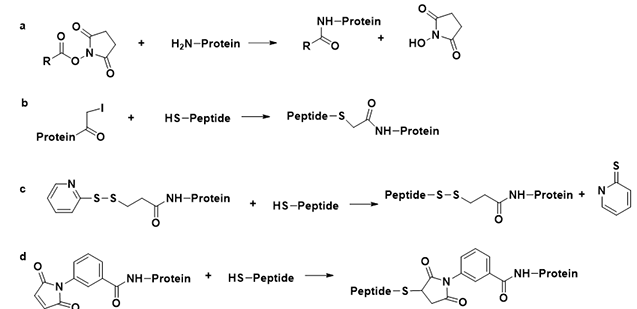A standard peptide of 15-20 amino acids in length is too small to elicit an immune response on its own. As a result, it is necessary to conjugate the peptide to a larger carrier protein. More importantly, there are three common purposes for conjugation of peptides. The most common is induction of humoral immunity. The majority of available pharmaceutical agents can not efficiently reach the brain parenchyma, which is one of the bottlenecks in the treatment of neurological and psychiatric disorders. One of the strategies developed to overcome this limitation is to conjugate the drug molecule to an antibody directly against one of the carrier proteins expressed on the luminal surface of brain capillary endothelial cells. Many peptides contain B-cell epitopes, but not T-cell epitopes. (Such molecules are called haptens.) Coupling these molecules to a large carrier protein containing T-cell epitopes allows the induction of a B-cell response to the entire immunogen, including the peptide. New synthetic peptides thus offer promise as vaccines.
For immunological reasons, the choice for carrier proteins usually ends at bovine serum albumin (BSA), ovalbumin (OVA), or keyhole limpet hemocyanin (KLH):
The most widely used strategy for preparation of peptide-carrier protein conjugates is solution conjugation. The majority of them react with the ε-amino group of lysine and/or the thiol group of cysteine. The solution strategy may be divided into:
1. one-pot: In the one-pot method, the cross-linking reagent and peptide are added to the carrier protein followed by dialysis to remove unwanted compounds.
 Fig.1 One-pot peptide-protein coupling reagents. a. Glutaraldehyde. b. Carbodiimides (Hansen et al. 2015)
Fig.1 One-pot peptide-protein coupling reagents. a. Glutaraldehyde. b. Carbodiimides (Hansen et al. 2015)
2. two-step conjugation method: In the two-step method, two separate reactions are used to form the covalent bond between carrier protein and peptide. In the first reaction, the cross-linking reagent is attached to the carrier protein via an amide bond. Gel filtration or dialysis is often used to remove excess of the coupling reagent, followed by conjugation of the peptide.
 Fig.2 Peptide-protein coupling reagents. a. General acylation step for the NHS esters LAAOSu, SPDP, and MBS. Second coupling step for IAAOSu, SPDP, and MBS (require Cys in the peptide sequence). b. IAAOSu. c. SPDP. d. MBS (Hansen et al. 2015)
Fig.2 Peptide-protein coupling reagents. a. General acylation step for the NHS esters LAAOSu, SPDP, and MBS. Second coupling step for IAAOSu, SPDP, and MBS (require Cys in the peptide sequence). b. IAAOSu. c. SPDP. d. MBS (Hansen et al. 2015)
Research shows that the conjugation of peptides bound to carrier proteins can provide a metabolic snapshot of diseased and normal tissues. Moreover, the low molecular weight peptide archive can be viewed as a direct reflection of the ongoing pathophysiology that can facilitate a true systems biology approach to biomarker discovery.
References